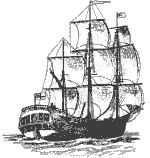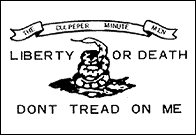

At left, a map of the Soblet family's jouney from the "Old World" to the "New World," courtesy of Online Map Creation.
"Like many others, the Soblet family immigrated to the New World to escape religious persecution and to find a new home with greater economic resources. The events leading up to the family's settlement in America as Huguenot refugees began in Sixteenth-Century Europe. ..."
The National Huguenot Society explains who the Huguenots were best.
I am a member of the thirteenth generation of Soblets. My great-grandparents were Maggie M. Weatherford (born 1890, West Virginia) and Allen Young.
"On April 19, 1700, the first of four ships, the Mary and Ann, left England with over 200 French and Swiss passengers, and would arrive that summer in Virginia. Among the passengers listed were Abraham Soblet and two children...."
"The second ship, the Peter and Anthony, arrived in Jamestown in October 1700; included on that ship were Abraham's wife, Susanne Soblet, and their three remaining children...."

At right, the Endeavor sailed in the same era as the Mary and Anna."
On the list of "Huguenot Refugees on Board Ship Mary and Ann, August 12, 1700, Virginia, James City," Abraham Soblet and his two children are listed as:
Abraham Sablet, et des deux enfants
On the list of "List of passengers from London to James River in Virginia, being French Refugees imbarqued in the ship ye Peter and Anthony, Galley of London, Daniel Perreau Commander (viz't) 20th of Sept. 1700 1700," Susanne Soblet and her thrree children are listed as:
Susanne Soblet and 3 enfants
Abraham Sablet is mentioned in a "Communication From Governor Francis Nicholson Of Virginia To the British Lords of Trade Concerning the Huguenot Settlement With "List of Ye Refugees," August 12th, 1700."
Susanne Soblet is mentioned in "Documents, Chiefly Unpublished relating to the Hugenot Emigration to Virginia and to the Settlement at Manakin Town, Published by the Virginia Historical Society in 1886."
On French Hugenots ~ Soblet/Sublett, the origins of the Huguenot Cross are discuseed, along with the origins of the Soblet/Sublett family in America.

At right, an African American family is separated by the slave trade. Picture is courtesy of Download-Free-Pictures.com.
"The 15 Xber, 1732, was born a black to Pierre Louis Soblet, his name is Pry= mus," was recorded in a
Note: Pyrmus was, in fact, born to Pierre Louis Soblet's slave, but since he "owned" his slave, it is recorded that Prymus was born to him.
William is named in his father's will in the Goochland Register.
Susanna was the daughter of William Allen III and Mary Hunt Minge Allen, widow of Robert Minge.
"The Allen Family" by Dr. Richard F. Wicker which covers the descendants of Captain William Allen and his two wives, Hannah Watson and Mary Hunt Minge. The descent of Captain William is based on research by MajGen Henry T. Allen done ca 1930 and has been double checked. Copies are still available for $30.00 from Wicker Publishing Co, 5136 Violet Bank Dr., Virginia Beach, VA 23464.Dr. R. F. Wicker, Jr." Susanna Allen was the daughter of Captain William Allen III.
Here's an interesting bit of trivia from Larry King:
Soure: King, Larry. "Anything Goes! : what I've learned from pundits, poliician, and presidents." New York, New York: Warner Books, Inc., 2000, p. 236.

At left, black & white portrait of Thomas Jefferson courtesy of FoundingFathers.info.
I am also related to John McCain through James W. Young, another maternal great-grandfather.
After the death of William Allen, Mary Hunt married Field Jefferson, the paternal uncle of president Thomas Jeferson.
Apparently, prenuptual agreements are not anything new. On Nov. 1, 1753 at Lunenburg Co VA, George Baskerville witnessed the prenuptual agreement between his mother-in-law Mary Allen and Field Jefferson.

At right, the flag of the Culpeper Minute Men. The Minutemen of Culpeper County, Virginia, chose a flag that includes the famous words of the man who organized the Virginia militia, Patrick Henry: "Liberty or Death." Picture of flag courtesy of Gadsden.info.
Rev. John Weatherford was "...one of the first Baptist preachers in America. Rev. Weatherford was thrown in the Chesterfield jail for preaching without a license. Patrick Henry represented him, in what was an early religious freedom case.The story is that the Rev. almost drove his jailors crazy with his loud and incessant preaching. The jailors beat him on the hands as he held himself up to the jailhouse window by the bars, leaving scars that remained for the rest of his life."
The following is a quote from Patrick Henry, Father of American Civil Liberties by Patrick S. Poole:
"In one instance a Rev. John Weatherford was imprisoned for five months on the charge of disturbing the peace by preaching. When Henry obtained an order of release, the jailer refused to let the prisoner free until he paid the prison fees, which had accumulated into a large sum due to the length of stay, added to the fact that the Rev. Weatherford refused to pay it. Weatherford was then released shortly thereafter, when he was informed that someone had paid his fees. It was not until twenty years later when Weatherford and Henry had removed themselves to Charlotte County that Weatherford learned for the first time that it had been Henry that had paid his fees. 4"
The following is a quote from the book This Day in Baptist History, written by Dr. Wayne Thompson and Dr. David Cummins:
Another account was published in The Reformed Reader.
On another Web page,, a page on the Web site of Weatherford Memorial Baptist Church which explains "why Weatherford memorial," it is written that "...Weatherford attempted to pay Henry for his services by sending him five pounds in gold, carefully wrapped in a kerchief. But Henry returned the gold, still wrapped in the kerchief."
You may find more on religious persecution in Virginia at the following URL:

This particular site shows a picture of Rev. John Weatherford in the Chesterfield County, Virginia prison.
The following is recorded of Rev. Weatherford and his imprisonment on a Web page of Bagby "Twigs of the Tree," the source being a book that he has in his possession:
"Elder John Weatherford was very successful in his ministry. His success roused the resentment of his Episcopal enemies, and he was soon thrown into prison, where he remained five months. But “his courage forsook him not. The love of Christ constrained him. He preached at the door of the prison as long as allowed the privilege; when refused that, he preached through the grates of the window. But such determined opposition did he meet, that an effort was made by his enemies to put a stop to that also. For this purpose, they built an outer wall above the grate. But Weatherford devised means to overcome the obstacle. A handkerchief, by the congregation, was to be raised on a pole above the wall, as a signal that the people were ready to hear. His voice being very strong, he could throw it beyond these impediments, and convey the words of life and salvation to the listening crowd…"
John Weatherford [is] Remembered as Unstoppable Dissenting Preacher at the following URL (The state historical marker found on VA 640 just south of the VA 57 intersection, at the entrance to Shockoe Baptist Church, is shown, as is the monument, erected in 1906 by the Pittsylvania Baptist Association, found in the Shockoe Baptist Church graveyard. Weatherford's actual gravesite is a quarter of a mile farther west.):
Also see: “GIVE ME LIBERTY OR GIVE ME DEATH:” A Picture Essay of Patrick Henry’s Famous Speech.
Richard E. Moore, my second cousin, 4x removed, was Rev. Weatherford's great-grandson. His life's stoy is real-life Civil War romance of love lost and won, and lost again.
Charles and Nancy Weatherford are buried in the family cemetery in Pittslyvania Co., VA. His father is buried in the Owen Burying Ground, 1/2 mi west of Shockoe.

At left, a scan of the doll that my great-grandmother, Maggie M. Weatherford, gave my mother.
See also: Genealogy Data for Sterling Price Weatheford m. Nannie Jane Farley
The ancestry of Sterling Price Weatheford and his mother Adeline Mobery Carr is traced in great detail at Virginians: The Family History of John W. Pritchett.
Maggie lived with my grandparents when she separated from Allen for a summer.
My mother loves treadle sewing machines because they remind her of the treadle machine that Maggie had. Maggie sewed some of my mother's clothes. My mother remembers that she would change into good school clothes at Maggie's place on her way to school. Maggie also sewed quilts. She liked straw hats.
My mother rememebers that Maggie made her own soap too.
See my recipe page for some recipes that my mother associates with Maggie and Allen.
William Soblet and wife, Susanna Allen, had a great-grandson named William Henry Herndon, who would become Abraham Lincoln's law partner. I am their 6th great-grandchild. William Henry Herndon was my 2nd cousin, five times removed.
But Lincoln believed above all in what he called "reason -- cold, calculating, unimpassioned -- reason."
"Billy," Lincoln said, "you're too rampant and spontaneous.""
William Soblet and wife Susanna Allen had a son named Philip Allen Sublett.
William Soblet and wife Susanna Allen had a grandson named Philip Allen Sublett.
On November 1, 1834, Sublett was elected second judge of the San Augustine municipality. He was represented as being of "good character" with a "knowledge of law of state and republic." In 1835 Sublett was elected chairman of the San Augustine Committee of Safety and Correspondence. On October 6 he submitted a resolution appointing Sam Houstonqv commander in chief of the forces of San Augustine and Nacogdoches districts until the Consultationqv should meet and make other arrangements. On October 19 Sublett led "seventy and upward well mounted men, and all well armed," from San Augustine into Nacogdoches en route to the Texas army besieging San Antonio. When Sublett's men arrived in Gonzales from Washington-on-the-Brazos on November 3, they found almost all of the men away in Stephen F. Austin'sqv army, and they perpetrated a number of outrages. According to John Fisher,qv secretary of the municipality's committee of public safety, the men from Ayish Bayou "entered private houses, compelled women to leave their house[es] with their children and seek protection from their neighbors, broke open doors, robbed of money, clothing, and everything they could lay their hands on, and dragged Dr. [Launcelot] Smitherqv from his bed and would have murdered him but for the interference of someone of the company who possessed some more of the milk of human kindness than the balance." Sublett was commissioned lieutenant colonel October 23, and on November 24 he was appointed as an appraiser to place a value on the horses and equipment of the volunteers. He was later named assistant adjutant general of the army. He served until December 14, 1835, and was present at the siege of Bexar,qv December 5-10, 1835, and although he opposed the plan to storm the city, he acted "with great bravery & coolness encouraging the men at every point" during the battle of Concepcion,qv according to Edward Burleson.qv On December 18, pleading the press of "private affairs," he declined the command of the First Regiment, Texas Volunteers, in favor of Edward Burleson. He thereupon returned to his farm, where on March 21 he was appointed to a committee to go to Fort Jessup, Louisiana, to inform the commandant of the perceived threat to Nacogdoches and San Augustine by hostile Indians thought to be gathering on the Trinity River. Houston resided in Sublett's home in July 1836 after being treated for a wound received during the battle of San Jacinto.qv On September 1 Sublett was appointed one of three commissioners to enroll a company of San Augustine militia in which he served as a private under Capt. D. Brown. On August 15, 1836, Sublett nominated Sam Houston for president of the Republic of Texas.qv Sublett was a developer of the town of Sabine, now Sabine Pass, at the mouth of the Sabine River. By 1840 he owned 1,400 acres of land, two town lots in San Augustine and 123 in Sabine, twenty slaves, fifty cattle, three horses, and a gold watch. Sublett died at his San Augustine home on February 25, 1850. When his wife died in 1891 she had been in Texas for seventy years, making her, according to contemporary newspaper accounts, the dean of Anglo-American Texans."
Philip A. Sublett had a nephew named Henry Williams Sublett.
"SUBLETT, HENRY WILLIAMS (1817-1859). Henry Williams Sublett, lawyer, jurist, and legislator, was born in Kentucky on May 27, 1817. He moved to Texas in March 1835 and settled east of San Augustine near his uncle, Philip A. Sublett.qv A lawyer by profession, Sublett was appointed district attorney for the Sixth Judicial District on January 15, 1842. He was an unsuccessful candidate for the Congress of the republic in 1845, but he represented San Augustine in the House of the First Legislature. He moved later to Travis County, which he represented in the Senate of the Fifth Legislature. On July 31, 1847, Sublett married Jane Bell (Belle) Anderson, daughter of Kenneth L. Anderson.qv At one time Sublett was a law partner of Oran M. Roberts.qv Henry Williams Sublett died in Austin on October 3, 1859, and was buried in Oakwood Cemetery, the name on the tombstone being spelled Sublitt."
Philip A. Sublett had a son named Frank Bolivar Sublett.
William Soblet and wife Susanna Allen had a great-great-grandson named William Caldwell Sublett.
The first Mumford name in Virginia was Thomas Mumford I. He was one of 120 settlers who arrived in the colony in the John & Francis and the Phenix about February 1608/9. The “First Supply,” as they called this tiny fleet, dropped anchor at Jamestown only about nine months after the first colonists arrived there on 13 May 1607.
Mumford was among the small band of fourteen explorers who accompanied Capt. John Smith on his exploration of Chesapeake Bay in 1608. Thomas also accompanied Captain Smith on his second voyage leaving Jamestown 20 July and returning 7 September 1608. Smith mentioned Thomas frequently in his narratives.
"Joseph established the DeJarnette family plantation, “Spring Grove,” in Caroline County, Virginia....
Daniel Coleman DeJarnette [, Joseph Sr.’s great-grandson], who built the present “Spring Grove,” had a seat in the Virginia House of Delegates (1853-58) and in the 36th U.S. Congress. He was reelected to the 37th Congress at the beginning of the Civil War, but declined the office. Daniel Coleman DeJarnette became a delegate in the Confederate Congress."
"In November 1635 at the age of twenty Richard Watkins left London to come to Virginia on the Abraham of London, John Barker, master."
"During 1700 four ships of Huguenots set sail for Virginia....We know much about the passengers on the first two ships, but have no record of those who were on the third ship. Some believe a Huguenot on the third ship was Jean deJarnat. He was about twenty then and settled in Gloucester County, where the births of his children were recorded in the Abingdon Parish Register."
For those of you who are really observant, the picture in the upper left-hand corner of this page is of a tree in the forefront of the skyline of Boston. (It was taken from the Esplanade.) To my knowledge, neither Jeremy nor I have any immediate family in Boston.
Send Jeremy or Rexanna an e-mail!
Optimized for Netscape 2.0 or better. Last Updated June 10, 2003.
Graphics provided by Animation Factory.
Graphics provided by Backgrounds Etc..
Copyright Rexanna M. Keats 1999, 2000, 2001, 2002, and 2003. All Rights Reserved.